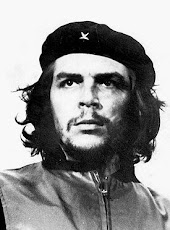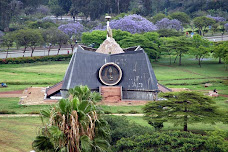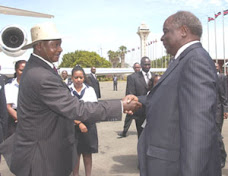Koitalel Arap Samoei A Nandi leader and an orkoiyot, a diviner. He detested the invasion of the British into the Nandi territory while building the Kenya-Uganda Railway. He prophesied that a black snake would tear through Nandiland and it would be spitting fire and would make its way into peoples' life. The construction of the railway saw this as a fulfilment of this prophecy.
He led the Nandi people into a fight against the builders of the Railway line for ten years. The British were determined to build the railway line and they tricked the orkoiyot into a meeting for an agreement, where a British commander shot Samoei and killed him during the conference. Without a leader, the Nandi were finally defeated in 1905 and the construction of the railway line continued without resistance.
Mekatilili Wa Menza Mekatilili led the Giriama people in a rebellion against the British, in what many had seen as a fulfilment of a prophecy, that she would be a leader of her people. This was a rare prophecy in a patriarchal community. She resisted British invasions and attempts to stamp out the Giriama traditional culture through the destruction of kaya, sacred forest shrines and places of worship.
She was then captured and exiled to Mumias in Western Kenya, where she was held together with Wanyi wa Madori her cousin. Five years later, she returned to the coast. Her inspiring story has been told by the modern woman to re-assert the woman's place in Kenya's history and destiny.
Waiyaki Wa HingaHe was a Gikuyu pre-colonial chief who ruled around Dagoretti. He encountered the British around 1890 when he signed a treaty with Fredrick Lugard of the Imperial British East Africa Company (IBEA), who later pitched their tent at Dagoretti.
Lugard and his men harassed the Gikuyu people and demanded for their food and their women. In retaliation the Kikuyu burnt down Lugard's fortress at Dagoretti. In 1892, the colonial administration kidnapped and took him to Coast where he is believed to have met his death. He was buried alive by his abductors. Bones believed to be his have been discovered after many years.
Dedan Kimathi He was the high priest of the Mau Mau movement, and the mention of his name spread fear among the settler community. At the height of the ongoing struggle for independence, he commanded thousands of fighters along the Aberdares. Kimathi became a cultic figure and his fame spread like bushfire.
An amount of sh. 10,000 reward was placed for whoever found him. He was eventually captured in October, 1956. He was sentenced to death by hanging and his remains are buried in an unmarked grave at the Kamiti Maximum Security Prison.
Harry Thuku He was born in Kiambu, educated at mission schools and then employed by the colonial government. In 1921, he founded the Young Kikuyu Association to protest against alienation of land, forced labour, taxation, low wages and the kipande laws. In 1922 he was arrested after being declared 'dangerous to peace and good order' and was detained for nine years. After his release he joined KAU (Kenya African Union) in 1944 and later joined KANU (Kenya African National Union) in 1960. He died in 1970.
Ezekiel ApindiHe was born in 1885 in Siaya. He went to a mission school and became a teacher in Mombasa. He later taught in Maseno School and became a member of the Young Kavirondo Association and the Piny Owacho movement. In 1931, he travelled to Britain to air the grievances of the Kenyan Africans to the British Parliament. He died in 1959.
Mzee Jomo Kenyatta Kenyatta was born in 1893, in Kiambu and was originally called Kamau wa Ngengi. He later changed his name to Johnstone Kamau when he was baptized. He joined a Mission in Thogoto in 1909. In 1928, he became the Secretary General of Kikuyu Central Association, (KCA).
He became the editor of Muigwithania from its beginning in 1929, which articulated the social issues of the Gikuyu before he got a job with the Nairobi City Council. In 1927, KCA sent Kenyatta to London to represent them in airing their land grievances. He made a brief return to Kenya in 1931 and stayed in Britain until 1946, during which he studied Anthropology and got married. He joined the Pan Africanists who pressed for Africa's independence.
In 1946, he returned and took leadership of Kenya African Study Union (KASU), the precursor of Kenya African Union. In October 20, 1952, Kenyatta and other nationalists were arrested for administering oaths and leading Mau Mau, which was an illegal movement. He was then sentenced to seven years imprisonment and released in 1961. He became the Prime Minister of independent Kenya and the first President of the Republic of Kenya until his death in 1978.
Ronald Ngala He hailed from Kilifi and was a student of Alliance High School and Makerere University. He became a teacher, although his interest was in politics and as result founded the Mijikenda Union in 1947. In 1957, he was elected as a member of Coast and in 1960, helped found the Kenya African Democratic Union, KADU.
In 1964, KADU and KANU merged and Ronald Ngala was appointed a minister where he served his country until his tragic death in a road accident in 1972.
Oginga OdingaOginga Odinga was born in 1911 in Siaya District and was a student of Maseno and Alliance High School. He then went to Makerere University and in 1940, he returned to Maseno High School as a teacher. In 1948, he joined KAU and in 1957 was elected to the Legislative Council as member for Nyanza Central. He was one of the founder members of KANU in 1960 and was its first vice-president. When Kenya became a Republic in 1964, he was President Kenyatta's first vice-president.
After a disagreement with KANU, he formed his own party in 1967, Kenya People's Union (KPU). It was banned in 1969 and Oginga was detained.
James Gichuru He was born in 1914 at Thogoto, Kiambu. He was educated at a mission school and Makerere College. In 1934, he qualified as a teacher and later ended his teaching career as a Headmaster when he became active in politics. He was one of the founders and the first president of KAU and in 1946, he stepped down from this post for Mzee Kenyatta.
During the State of emergency he was restricted at Githunguri from 1955 to 1960. After the restriction was lifted he joined politics again and helped found KANU, of which he was again the first president. He served as a government minister from 1962 until his death in 1982.
Daniel Arap Moi Daniel Toroitich Arap Moi was born in Baringo District in 1924. He studied at Kabartonjo, Kapsabet and the Government African School at Kabarnet. He then followed a teaching career, becoming the Headmaster of Tambach Primary School and Assistant Principal of Tambach Teachers Training College. In 1955, he joined politics and became a member of the Legislative Council. In 1957, he was chosen as a Legco member for Rift Valley.
Daniel Moi became a member of Kenya's first Republican Cabinet in 1964. In 1967, he became the Vice-President and Minister of Home Affairs where he served until the death of Mzee Kenyatta. He was elected President in 1978 and since then he has led Kenya's development in the light of the Nyayo philosophy of peace, love and unity.
Tom MboyaHe was born in 1930, near Thika, although his parents came from Rusinga Island. In 1951, he began working with the Nairobi City Council after completing his education from the then Royal Sanitary Institute at Kabete.
He was a keen trade unionist and a member of KAU until it was banned. By October 1953, he became the Secretary General of the Kenya Federation of Registered Trade Unions, KFRTU, which later became the Kenya Federation of Labour in 1955.
He was elected as member of Legco for Nairobi in 1957. In 1960, he helped to found KANU and became its Secretary General. He was Minister of Justice and Constitutional Affairs in the first KANU government and later became Minister of Economic Planning. He was assassinated in 1969 by a gunman outside a shop on Nairobi's Government Road, now Moi Avenue.
Thursday, January 17, 2008
Subscribe to:
Post Comments (Atom)






















No comments:
Post a Comment